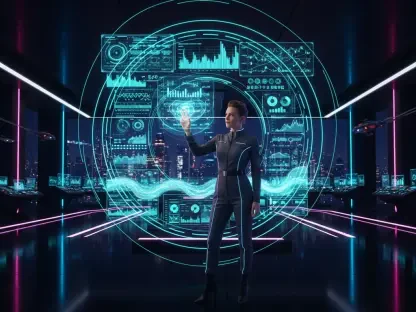In the rapidly advancing realm of cybersecurity, Chief Information Security Officers (CISOs) are adopting new strategies to protect their organizations. Facing sophisticated cyber threats driven by remote work, cloud usage, and the proliferation of IoT devices, these leaders are turning to artificial intelligence (AI), automation, and Zero Trust architecture for a stronger defense.
Overview of Current Cybersecurity Challenges
The Evolving Threat Landscape
In today’s digital age, organizations are confronted with a diverse range of cyber threats, exacerbated by remote work and cloud adoption. Traditional perimeter-based security models are no longer sufficient. These security measures were designed for a time when network boundaries were more clearly defined. However, with the increasing integration of cloud services and IoT devices, these boundaries have become porous and indistinct. The threat landscape has never been more varied, incorporating well-known tactics such as phishing along with newer, more sophisticated AI-driven malware.
Ransomware-as-a-service has emerged as a particularly pernicious threat. It allows even less technically skilled criminals to launch damaging attacks with relative ease. These sophisticated threats highlight the inadequacy of legacy systems and underscore the need for more dynamic and layered defense mechanisms. The dynamic nature of modern threats demands that organizations move beyond traditional reactive measures. Proactive steps, including continuous monitoring and real-time threat intelligence, are becoming essential components of effective cybersecurity strategy.
The Complexity of Modern Threats
Adding to the challenge are the complexities introduced by modern threat actors, including external attackers, insider risks, and supply chain vulnerabilities. External actors often use spear-phishing campaigns to gain initial access before moving laterally within a network. Insider threats can arise from disgruntled employees or those unknowingly compromised. Furthermore, with businesses increasingly relying on third-party vendors, supply chain vulnerabilities present another significant risk. Hackers can exploit weak links in the supply chain to access larger targets.
Attackers now deploy multi-faceted campaigns combining various attack vectors to achieve their objectives. This sophistication requires equally advanced defense strategies. Organizations must foster an environment where security is interwoven with business operations. They must also ensure their teams are prepared to identify and respond to anomalous behaviors. To stay ahead, organizations must constantly evolve their cybersecurity defenses, encompassing a balanced mix of technology, processes, and skilled personnel.
AI: A Game-Changer in Cybersecurity
Leveraging AI for Threat Detection
Artificial intelligence is revolutionizing cybersecurity by processing vast amounts of data in real-time and identifying patterns and anomalies. Unlike traditional systems that rely on predefined signatures, AI-driven tools can detect novel threats by learning from vast datasets. These tools have the ability to scan and correlate data across disparate IT environments. Leveraging machine learning algorithms, AI systems can adapt to the ever-changing threat landscape. This adaptability is especially critical given the diverse and rapidly evolving nature of cyber threats.
AI-powered systems are particularly adept at detecting suspicious behaviors and potential breaches that would go unnoticed by human analysts. By continuously learning from the data they process, these systems can improve their threat detection capabilities over time. This enables organizations to identify threats at their earliest stages, significantly reducing the risk of successful attacks. Besides, AI can predict vulnerabilities, enabling organizations to address potential security gaps before they can be exploited.
Enhancing Reactive and Proactive Defense
Machine learning algorithms analyze user activities to establish baseline behaviors and identify deviations. This continuous behavioral analysis helps in early identification of potential insider threats and external intrusions. Anomalies such as unusual login times, access to sensitive data without a business need, or sudden spikes in network traffic trigger immediate alerts. This proactive approach not only allows for swift detection but also aids in formulating an effective response.
In addition to enhancing threat detection, AI plays a crucial role in streamlining incident response processes. Through automated playbooks, AI systems can suggest and, in some cases, implement pre-defined responses to mitigate detected threats. This ensures that even organizations with limited cybersecurity staff can effectively manage and respond to incidents. By reducing the time from detection to response, AI ensures that organizations can minimize potential damage and recover more quickly from cyber incidents.
Addressing the Cybersecurity Skills Gap with Automation
The Demand for Skilled Professionals
CISOs are grappling with a significant skills gap, as the demand for skilled cybersecurity professionals far exceeds supply. This shortage leaves security teams under-resourced and struggling to manage the influx of daily alerts. With so many threats to monitor, human analysts can become overwhelmed, leading to potential oversight and burnout. The cybersecurity landscape is evolving faster than the workforce can adapt, making it critical to find solutions that alleviate the burden on existing teams.
Academic institutions and training programs are ramping up efforts to produce more qualified professionals, but these solutions take time. Meanwhile, existing cybersecurity teams are often inundated with more work than they can handle effectively. Significant effort is required for continuous education and upskilling to keep pace with new threat vectors. The gap leaves organizations vulnerable and highlights the urgent need for technological solutions that can assist human teams in tackling these challenges.
The Role of Automation
Automation aids in triaging alerts based on priority and reducing the number of false positives analysts must review. This streamlining of incident response processes is crucial in maintaining the integrity of cybersecurity operations. By filtering out noise and presenting only the most critical alerts, automation ensures that security teams can focus their attention on the most pressing issues. Automated systems can handle routine tasks such as log analysis, patch management, and initial threat assessments without human intervention.
In addition to triage, automated workflows can further enhance efficiency by executing predefined response actions. For example, compromised accounts can be locked, or malicious emails can be quarantined immediately upon detection. This not only accelerates incident response times but also minimizes the window of opportunity for attackers to exploit vulnerabilities. Automation, therefore, acts as a force multiplier, helping understaffed security teams maintain a high standard of protection while improving overall operational efficiency.
Zero Trust Architecture: Redefining Security
The Principles of Zero Trust
Zero Trust represents a shift in security paradigms by operating on the principle of “never trust, always verify.” Unlike traditional models that assume trust within the network perimeter, Zero Trust requires continuous validation for access. Every user, device, and application, whether inside or outside the organization, must be authenticated and authorized before granting access. This strict approach mitigates the risk of insider threats and lateral movement by attackers who gain initial access to the network.
Zero Trust mandates least privileged access, ensuring that users and devices only have the minimal access necessary to perform their roles. Access permissions are continuously evaluated and adjusted based on factors such as device health, user behavior, and location. Network segmentation, another pivotal aspect of Zero Trust, breaks down data and resources into smaller, isolated zones. This micro-segmentation limits the damage that can occur in the event of a breach, containing potential threats to distinct segments of the network.
Securing Remote and Cloud Environments
Zero Trust is particularly effective for remote work environments, ensuring rigorous authentication protocols, such as multi-factor authentication (MFA). The proliferation of bring-your-own-device (BYOD) policies and remote work necessitates robust security measures. Zero Trust ensures that access requests are continuously authenticated based on real-time evaluations of risk. This includes analyzing contextual attributes such as user roles, device health, and behavioral patterns to grant or deny access.
Cloud environments also benefit from the Zero Trust model. As organizations migrate more workloads to the cloud, the traditional network perimeter further dissolves. Implementing Zero Trust in cloud environments ensures continuous monitoring and secure access to resources regardless of user location. Micro-segmentation and least privileged access controls minimize the risk of data breaches and unauthorized access. Incorporating AI-driven insights enhances the ability to detect and respond to potential security incidents in real-time, ensuring that cloud and remote assets remain secure.
Synergistic Integration of AI, Automation, and Zero Trust
AI Provides Intelligence
By analyzing vast amounts of data, AI detects threats and predicts vulnerabilities. AI systems can process and correlate diverse data points from various sources, creating a comprehensive and detailed view of the organization’s security posture. The intelligence provided by AI systems is invaluable in identifying patterns that signify threats, enabling preemptive measures. Predictive analytics powered by AI can forecast potential attack vectors, allowing organizations to bolster their defenses proactively.
Moreover, AI supports continuous learning and adaptation, which is essential in the face of ever-evolving threats. By learning from past incidents and new data, AI systems can continually refine their threat detection algorithms, keeping pace with sophisticated attack methods. This continuous learning loop enhances the accuracy and effectiveness of automated threat detection and response processes, making AI a pivotal component of modern defense strategies.
Automation Delivers Efficiency
Automation enhances operational efficiency by handling routine tasks and enabling rapid responses to security incidents. Automated systems free up human analysts from the tedium of repetitive tasks, allowing them to concentrate on complex and strategic security challenges. Automated workflows can handle everything from initial threat detection to executing response protocols, significantly reducing the time from threat identification to mitigation.
Automation is also vital for maintaining compliance with regulatory requirements by ensuring that security protocols are consistently applied and audited. Automated systems document every action taken, creating an auditable trail that simplifies compliance reporting and post-incident analysis. This consistent enforcement of policies reduces the margin for error and ensures that security measures are in place and effective at all times, regardless of staff availability or workload.
Zero Trust Establishes Control
Zero Trust ensures continuous verification and access restriction based on risk assessments, thereby establishing a high degree of control over who and what accesses organizational resources. This approach minimizes the attack surface and prevents unauthorized access by continuously validating users and devices. By integrating AI’s predictive capabilities with Zero Trust’s stringent access controls, organizations can enhance their threat detection and response strategies.
Within this integrated framework, AI-driven insights can inform automated responses in a Zero Trust environment, blocking or isolating compromised systems without the need for manual intervention. This synergy between AI, automation, and Zero Trust results in a proactive, adaptive defense mechanism capable of addressing the complexities of modern cyber threats. It enables organizations to dynamically adjust their security postures based on real-time data, ensuring a robust and resilient defense.
Challenges in Implementation
Legacy Systems and Cultural Resistance
Implementing AI, automation, and Zero Trust technologies can be hindered by outdated infrastructure and resistance from employees due to perceived complexity or surveillance concerns. Legacy systems may not be compatible with modern security technologies, necessitating significant upgrades or replacements, which can be costly and time-consuming. This transition phase can disrupt business operations, causing concerns among stakeholders about the return on investment.
Cultural resistance is another major obstacle. Employees might view these technologies as overly invasive or fear that their work will be closely monitored, reducing their sense of autonomy. CISOs must communicate the benefits of these technologies, emphasizing how they enhance security and enable employees to focus on more meaningful tasks. Training and comprehensive change management strategies are essential to mitigate resistance, ensuring a smoother transition and better acceptance of new tools and processes.
Cost and Complexity
Advanced solutions require significant investment in both technology and training. Implementing AI, automation, and Zero Trust necessitates financial commitment not only for initial setup but also for ongoing maintenance, updates, and training programs. This can be a substantial burden for organizations, particularly smaller ones with limited budgets. Moreover, the complexity of integrating these technologies into existing workflows demands meticulous planning.
To successfully deploy these technologies, organizations must carefully evaluate their current infrastructure and develop a phased implementation plan. Piloting specific processes or starting with high-risk areas can help demonstrate early successes, building momentum for broader adoption. Continuous training programs ensure that staff remains adept at utilizing new tools effectively, maximizing return on investment. Clear communication about the strategic value and long-term benefits of these technologies is vital to secure organizational buy-in and funding.
Future Directions for Cybersecurity
In the swiftly evolving field of cybersecurity, Chief Information Security Officers (CISOs) are embracing innovative strategies to protect their enterprises. As cyber threats become more sophisticated, driven by factors like remote work, cloud computing, and the expansion of IoT devices, these security leaders must continually adapt. To fortify their defenses against these complex threats, CISOs are increasingly leveraging artificial intelligence (AI), automation, and Zero Trust architecture.
AI and automation help in identifying and responding to threats at unprecedented speed and scale, reducing the likelihood of successful attacks. Zero Trust, a security model that requires verification for every person and device trying to access resources, is gaining traction for its robust approach. It’s becoming clear that a traditional perimeter-based defense is no longer adequate. As CISOs develop and implement these advanced strategies, they’re not only enhancing their security but also ensuring the resilience and continuity of their organizations in the face of evolving cyber threats.









